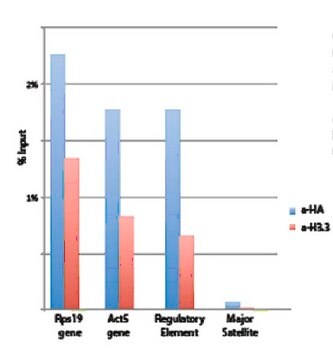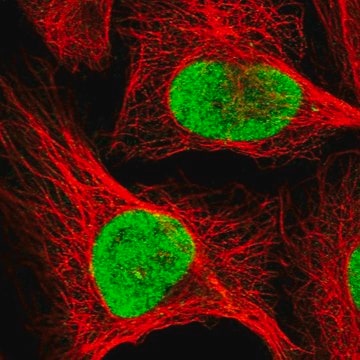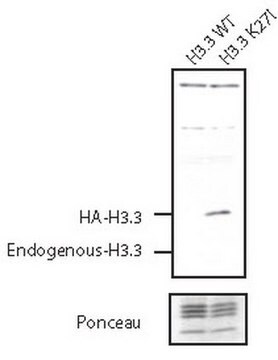ABE419
Anti-Histone H3.3 Antibody, K27M mutant
from rabbit, purified by affinity chromatography
Synonim(y):
Histone H3.1, Histone H3.3
About This Item
Polecane produkty
pochodzenie biologiczne
rabbit
Poziom jakości
forma przeciwciała
affinity isolated antibody
rodzaj przeciwciała
primary antibodies
klon
polyclonal
oczyszczone przez
affinity chromatography
reaktywność gatunkowa
mouse, human
metody
ChIP: suitable
immunohistochemistry: suitable
western blot: suitable
numer dostępu NCBI
numer dostępu UniProt
Warunki transportu
wet ice
docelowa modyfikacja potranslacyjna
mutation (Lys27Met)
informacje o genach
human ... H3F3B(3021)
Opis ogólny
Specyficzność
Immunogen
Zastosowanie
- Peptide Inhibition Assay (PIA): Target band detection inlysate from HEK-293 cells transfected with Histone H3.3 K27M mutant wasprevented by pre-blocking of a representative lot with the immunogen HistoneH3.3 K27M mutant peptide, but not the corresponding unmodified Histone H3.3 peptide.
- Immunohistochemistry (IHC): A representative lot of this antibodydetected Histone 3.3 K27M in pediatric glioblastoma tissue sections. (Venneti,S., et al. (2014). Acta Neuropathol 128(5); 743-753).
Epigenetics & Nuclear Function
Histones
Jakość
Western Blotting Analysis (WB): A 1:2,000 dilution of a representative lot of thisantibody detected Histone H3.3 K27M in HEK-293 cells transfected with HistoneH3.3 K27M mutant.
Opis wartości docelowych
Postać fizyczna
Przechowywanie i stabilność
Komentarz do analizy
Lysates from MEF transfectants expressing K27M (positive) or wildtype (negative) FLAG-HA-tagged histone H3.3.
Inne uwagi
Oświadczenie o zrzeczeniu się odpowiedzialności
Nie możesz znaleźć właściwego produktu?
Wypróbuj nasz Narzędzie selektora produktów.
Kod klasy składowania
12 - Non Combustible Liquids
Klasa zagrożenia wodnego (WGK)
WGK 1
Temperatura zapłonu (°F)
Not applicable
Temperatura zapłonu (°C)
Not applicable
Certyfikaty analizy (CoA)
Poszukaj Certyfikaty analizy (CoA), wpisując numer partii/serii produktów. Numery serii i partii można znaleźć na etykiecie produktu po słowach „seria” lub „partia”.
Masz już ten produkt?
Dokumenty związane z niedawno zakupionymi produktami zostały zamieszczone w Bibliotece dokumentów.
Nasz zespół naukowców ma doświadczenie we wszystkich obszarach badań, w tym w naukach przyrodniczych, materiałoznawstwie, syntezie chemicznej, chromatografii, analityce i wielu innych dziedzinach.
Skontaktuj się z zespołem ds. pomocy technicznej








